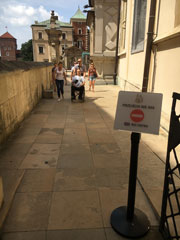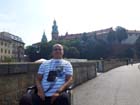Trip to Kraków
Sightseeing in Kraków for people with disabilities using a wheelchair
Sightseeing in Kraków while using a wheelchair can be full of unique experiences as well as challenges. In the guide below, I share my experiences from visiting various monuments and attractions in Kraków, along with useful tips and advice for travelers with disabilities. I started my tour at the Kościuszko Mound and finished at Wawel Castle, and below I present the details of my journey.
Hotel for people with disabilities in Kraków
While planning our trip to Kraków, we chose the Ibis Budget hotel located at Armii Krajowej Street 11A. When selecting accommodation, we were guided primarily by the absence of architectural barriers that make everyday life difficult for people with disabilities, the price, and the distance from the Main Market Square. The room fully met our expectations: it was located on the ground floor and was spacious enough to move around in a wheelchair, the bathroom was well adapted for people with disabilities, there was efficient air conditioning and tasty breakfasts, and the hotel was only a 10-minute drive from the Market Square.
Kościuszko Mound and wheelchair users

I began my sightseeing tour of Kraków as a wheelchair user at Kościuszko Mound, located in the western part of the city and surrounded by a beautifully restored citadel fort. It is one of five Kraków mounds, completed in 1823 and built in memory of our national hero. The mound is 35 meters high and offers a wonderful panorama of the capital of Lesser Poland and the Kraków-Częstochowa Upland.
Getting to Kościuszko Mound is not a problem; however, it is best to drive to the very end of the main road, pass a huge cannon barrel on the left, and park as close to the ticket office as possible. When purchasing tickets at the mound's ticket office, we informed the staff that one person had a disability and used a wheelchair. Thanks to this, we entered the mound at the point where walking visitors finish their tour. There is no other way to enter Kościuszko Mound. Current ticket prices and opening hours can be found here.
Kościuszko Mound surprised me with its height and steep paths. I thought my friend would not manage to push me all the way to the top, but just before the final section I gave up myself because I felt unsafe. The wheelchair-unfriendly surface (rather uneven cobblestones), narrow and steep paths without handrails made me feel anxious. Fortunately, the view fully compensated for the stress I experienced during the ascent. Thanks to the sunny weather, Kraków revealed itself in all its splendor, and I was glad that I would soon be able to see its most important landmarks up close.
Descending from Kościuszko Mound was equally unpleasant and stressful. The safest option was to move slowly backward. Fortunately, nothing unexpected happened and we safely left the mound at the same place where we had entered. Earlier, we had asked the ticket clerk for the keys to remove the barriers preventing wheelchair access.

Main Market Square in Kraków
After a short rest following our visit to Kościuszko Mound, our next destination was Kraków's Main Market Square. Thanks to the parking card, we had no problem finding a parking space near the square. Currently, a zero parking fee applies for people with disabilities in designated blue parking spaces.
After passing through several streets with relatively flat and comfortable paving, we reached the largest and probably the most beautiful market square in Poland. This place made a very positive impression on me due to its size and beautifully restored townhouses, and the Cloth Hall located in the center impressed us with its architecture.
Next, we went to St. Florian's Gate and the Barbican, which once guarded the entrance to Poland's former capital. After returning to the square, we planned to visit St. Mary's Basilica, but this turned out to be impossible due to an ongoing mass. We only managed to walk around this very distinctive building, hear the trumpet call played every hour from the tower, have a meal in one of the many restaurants, and conclude the first day of our trip.

Wawel for wheelchair users
We began the last day of our trip to Kraków by visiting Wawel Hill. First, we walked along the beautiful Vistula boulevards to see the Wawel Dragon, and then, after a rather demanding climb, we were welcomed by the impressive monument of Tadeusz Kościuszko, funded in the 1960s by the residents of Dresden as a gesture of reconciliation. After a few wide and low steps, we finally reached the place that once served as the residence of 17 Polish kings.
Wawel Castle, its architecture, and its size made a huge impression on me. It clearly reflects the former power of the Polish state. I am proud that our ancestors created something so magnificent, which has survived almost unchanged to this day. I had no problem reaching the castle courtyard and the cathedral in a wheelchair, where beautiful and impressive tombs of Polish kings are located.
Summary of the trip to Kraków
For people with disabilities, Kraków offers many adapted tourist attractions that can be visited without major difficulty while using a wheelchair. Sightseeing in Kraków is an unforgettable experience. To fully enjoy your stay in this region, I recommend a visit to the Wieliczka Salt Mine, which is perfectly adapted for people with disabilities.
I am glad that my next trip came to fruition and that I was able to visit places I had previously known only from the media. The panorama from Kościuszko Mound, the vast Main Market Square, the Cloth Hall, St. Florian's Gate, and the Barbican are places I will remember forever. Even though we did not complete the entire planned itinerary (we did not visit the interior of St. Mary's Basilica with the altar by Veit Stoss), I consider the trip to Lesser Poland very successful.













 PL
PL
 DE
DE